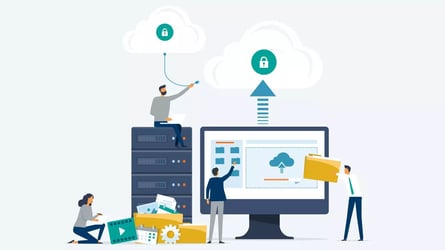Guest Blogger
Today, we have over 6 billion smart devices, mostly smartphones and TVs that are connected to the Internet. Smart devices like these are called the Internet of Things (IoT) and there’s going to be a whole lot more of them soon.
In just a few years, there will be smart cars driving themselves down the road, smart homes setting their thermostats to the perfect temperature, and even smart cities, where large sets of data can be analyzed to improve the health and safety of the citizens.
The problem is in the next 5 years there will be almost 50 billion IoT devices connected to the Internet.
With such this exponential growth, the cloud will not be able to store all that data. As Jonathan Wilkins, the head of marketing for EU Automation, says, "The IoT can only happen through cloud, but today's cloud infrastructure still has a long way to go before it can accommodate for the huge amounts of data that connected devices will generate."
In order to accommodate the influx of data these devices will bring, the cloud is turning into "the fog."
Fog computing (also known edge computing) is made up of nodes or gateways that can store data before it is sent to the cloud. These nodes can be housed in any location, on a factory floor, on top of a power pole, alongside a railway track, in a vehicle, or even on an oilrig, it doesn’t matter. Any device with computing, storage, and network connectivity that can store, organize, and analyze data before it is sent to the cloud can be a part of the fog.
Fog computing will provide all the space that the cloud cannot, plus it will allow for three major advancements, which will allow for faster, cheaper, and safer data storage.
Latency
By the time we have 50 billion devices sending data back to the cloud at once, things are going to slow down. Information will inevitably bottleneck, causing dramatic spikes in latency, which will make IoT devices less smart, which will defeat their purpose entirely.
Latency issues are especially problematic with IoT devices because they are often made to transmit any and all data they intake, regardless of how useful it may seem. Since these objects rarely turn off, they are usually transmitting tons of data non-stop.
In the end, all this data is going to be too much to sift through. As Don DeLoach, co-chair of the ITA Midwest IoT Council, says, "One of the downsides of storing vast amounts of data is [the time it takes to find any useful insights]. If each dataset is over a petabyte and I'm running complex queries, it might take five hours just to get my answer back. If I don't even know if I'm asking the right question, that's a big price to pay."
Fog computing allows for the most important data to be separated from the less important data. Useful data can then be stored in nearby nodes, where it can be analyzed in real-time. This process is called "data-thinning" and it can drastically minimize latency. When important data is thinned from less important data, the non-essential data can still be sent to the cloud, where it can be analyzed over longer periods of time, or even discarded as needed.
For example, driverless cars are going to create a lot of data that doesn’t need to be analyzed or stored. A single car has the ability to create petabytes of data every year – by taking millions of images of every street the car drove down, which are not particularly useful. So, when it comes to IoT, too much data can actually be harmful. Fog computing solves this problem by allowing the less useful information to be discarded before it is sent to the cloud, which makes the cloud smarter too.
Bandwidth
Often times, data is sent to cloud locations on the other side the world, which can take up a lot of bandwidth. Sending a single packet of data across the Pacific Ocean may not take much, but when big sets of data need to be analyzed afar, a lot of bandwidth can be wasted, especially when it comes to billions of IoT devices sending so much data.
However, when IoT data is stored in near-by fog nodes, bandwidth is minimized by offloading gigabytes of traffic from the network at the source.
Saving small amounts of bandwidth can end up making a big difference over time. Below is a table from a study by Wikibon that found how much cheaper it can be to use fog computing, rather than solely using the cloud.
When you are able to sort out the information before it is sent out to the cloud to be analyzed, you can get just the right information that you need for immediate concerns, rather than sorting through Petabytes of unnecessary data.
Security
IoT devices also create major security issues. When all of your devices are connected to your network, they are more vulnerable to hackers. Since, your smart home can recognize your car and connect with it, a hacker simply has to enter your network through your car or your garage, or any other device. From there, they can travel through your network until they find more relevant data. And, with everything connected through the cloud, all of your data is vulnerable.
Security expert, Bruce Schneider puts it simply, "If we cannot secure complex systems, we can’t build a world where everything is computerized, connected, interconnected, and intermingled."
Under the cloud-centric structure, businesses and homes with IoT devices will become easy targets for hackers, who will have numerous points of entry to your network. But with fog computing, all of these devices can be protected through a single node per network location, which can be secured with encryption, password protection, firewalls, or many other security measures.
The rise of IoT has caused a lot of problems for the cloud, but the solutions that fog computing has provided are actually making the cloud much more efficient at data storage. The table below, from Cisco Blogs, shows the many advantages that fog computing can bring to the cloud.
Having a faster, cheaper, and more secure cloud by utilizing fog computing, has changed the cloud for the better.




